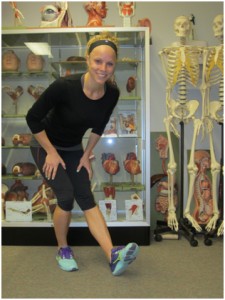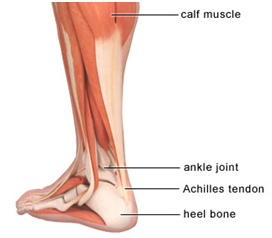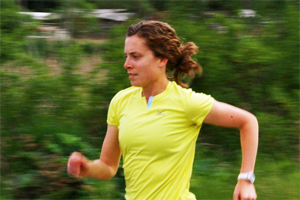 By: Nikki Reiter
By: Nikki Reiter
Some runners love to stretch. You often see them breaking for a quick stretch in the park, limbering up for a race, or hanging around post-run chatting while posing in strange positions. Could these activities actually be harming them? Every once in a while, along with the latest training fad, you may hear “stretching is bad for you” or “you should only stretch dynamically” or “men can stretch before running, but women shouldn’t”…really? Student researcher Carey Simpson, at the University of British Columbia Okanagan, has been stretching subjects and measuring the associated changes in their tendon length. She has discovered evidence that suggests that women may be at a real disadvantage when it comes to statically stretching the Achilles tendon just prior to running.
For her study, Simpson had healthy, active, male and female subjects come into the lab and, using ultrasound techniques, she measured their Achilles tendon, which is the long strip of tough, fibrous tissue that connects your heel bone to your calf muscle. Functionally, the Achilles tendon will absorb and return energy when running, working much like stretching and releasing energy in an elastic band. Subjects then had their Achilles tendon statically stretched for two minutes (in a similar way as demonstrated by Carey in the photo). When measuring the tendon after the stretching intervention, male and female subjects demonstrated very different reactions.
While women demonstrated that they could increase the length of their Achilles tendon, men demonstrated greater changes to the structure of the calf muscle, (note the different structures in the diagram).

So, what does this mean? Simpson explains that “when pushing off the ground, if a woman has elongated her Achilles tendon, she will then have to ‘take up’ the slack before her calf muscles can contract to produce the forces needed for running.” This not only inhibits performance, but the increased laxity of the Achilles tendon also means increased ankle joint mobility, which puts a lot of stress on the knee to be a more stable structure in running. “The idea of increased joint laxity, in general, for women, is a relatively known occurrence, however it hasn’t yet been investigated with the Achilles tendon,” says Simpson. Bottom line, “stretching the Achilles before running may be detrimental for women.” For men, the immediate effects of statically stretching the Achilles results in reorientation of the muscle fibers in the calf into a position that can produce more force. “This is great for pushing off the ground, but it’s unknown how long the effect lasts and whether it changes gait patterns,” Simpson explains.
Runners tend to stretch for a variety of reasons; perhaps it’s because it makes them feel good, or they feel the need to prepare for exercise. Perhaps they believe it will ward off injuries. Perhaps they’ve just been told to do so! Whatever the reason, it’s important not to change your training based on the results of one study. If what you’re doing works for you, then keep at it! If you’re continually getting injured, and traditional rehabilitation isn’t working for you, maybe it’s time to think outside the box!
Happy Running!
***

Nikki Reiter is a Mizuno Running Brand Ambassador from Kelowna, BC. She holds a master’s degree in biomechanics, coaches Cross Country at UBC Okanagan and is the founder of Run Right Gait Analysis Service (run-right.ca).





 Current Issue
Current Issue Previous Issue
Previous Issue Prior Release
Prior Release
